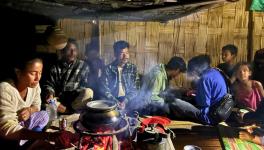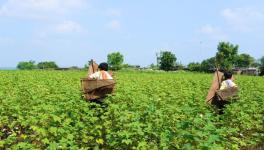With Affordable Tech, Loan Support can Bring Natural Fibres to Life in Karnataka
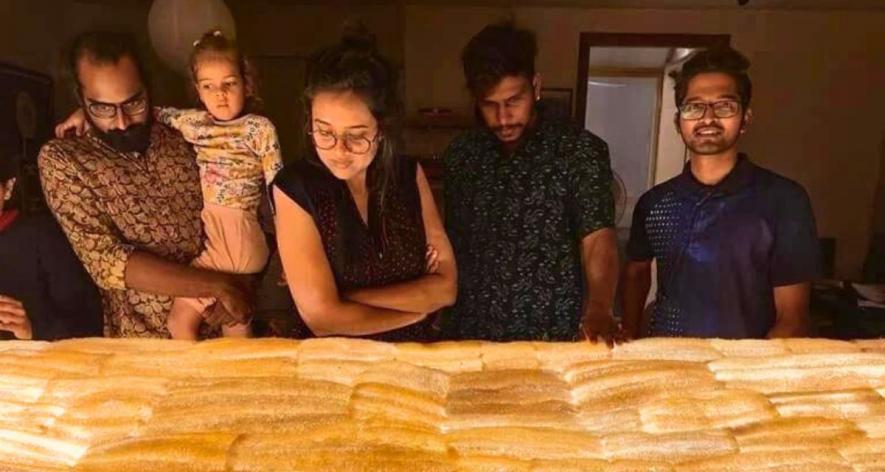
Chamarajanagar, Karnataka: Standing under a canopy of trees, Venkatesh Nagsetti (38) and his brother Prasad Nagsetti (35) are spinning ropes from the dried leaves of agave plants (agave sisalana). They belong to the only family that makes sisal, a natural fibre obtained from agave, in Kuderu village of Karnataka’s Chamarajanagar district.
Their father, Nagsetti (60), mother Sannamathamma (60), Venkatesh’s wife Rekha (28) and Prasad’s wife Ramya (25) help with the tasks. The family has been in this job for four generations. They belong to the Uppara caste, traditionally associated with digging earth, building tanks and making salt.
“We are in this business because we do not like migrating to cities. We are not educated, so we would not get high-paying jobs in cities either,” Venkatesh tells 101Reporters.
Earlier, around 100 families of Kuderu, Tenkalmole and Badagalamole were involved in making sisal ropes. They stopped using the natural fibre 20 years ago, as the work was strenuous. They now make reusable plastic ropes from cement packaging bags.
Agave plants grow on bunds across the fields and wastelands in the arid and semi-arid regions of Chamarajanagar, Hanumanthapura, Heggodu, Ummathur and Mysuru. The plant is drought-tolerant but grows well when water is available. Once the fleshy leaves are harvested, it takes around six months for the next harvest.
The Process
Hunting down agave leaves suitable for making ropes is integral to the work. “We are used to constant travels to nearby Mysuru, Mandya and Bengaluru regions in search of material. Despite the changing climate, we have not had great difficulties so far in procuring leaves. When the underground adventitious shoots developing from the roots receive favourable conditions, they often come up above the soil surface at some distance from the parent plant and develop into small suckers. These new plants ensure our raw material,” says Venkatesh.
For the last 50 years, the family has been using a sugarcane crusher machine with a diesel engine to extract sisal fibre. Venkatesh has to remain standing in a bent position throughout the process. It is done by hand, and there are chances of injuring one’s hand when the machine is running. More people are needed for the process, which includes feeding leaves into the crusher, putting cold water when the machine heats up and hanging the fibre to dry.
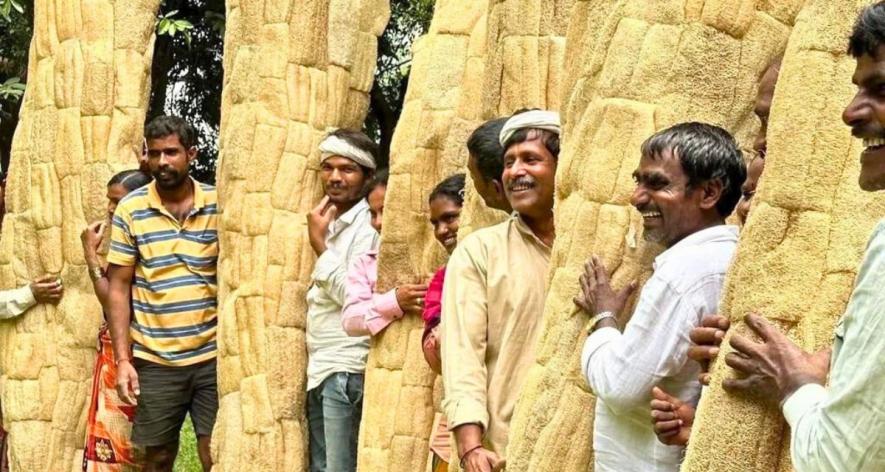
“Modern machines that run on electricity/solar energy could save the huge amounts that we spend on diesel. Newer technologies will raise productivity and income, but they cost a lot,” says Venkatesh.
Explaining the economics of making ropes, he says, “For procuring agave leaves, we have to give Rs 300 to 500 to land owners. We spend a total of Rs to employ four labourers [Rs 500 each] to cut the leaves and load and unload them into a hired tractor and for transportation. The raw fibre is sold for Rs 80 per kg.”
To run the crusher, diesel worth Rs 500 and oil worth Rs 300 are needed daily. The family works 16 days a month (four days a week). They do all the work themselves as they cannot afford labour charges. They should ideally wear a full-body suit as the juice is allergic, but they manage with hand gloves and full-sleeve shirts. They are sure they can produce an additional 30 kg of the fibre against the present weekly output of 100 kg, provided they have the right machine.
Contrastingly, reusable plastic ropes are sold at Rs 30 per kg, as they have no processing cost. Each bag costs Rs 2 to 3, and the plastic rope-makers purchase 100 sacks of 25-kg cement bags to manufacture 90 ropes. When compared to natural fibre rope, the work is less strenuous and they earn between Rs 4,000 and 5,000 a week.
In the case of natural fibre rope, three to five persons are required to make one batch of rope manually. “The spinning wheel has to be often turned full 360 degrees to produce a batch of rope,” Rekha says. Ramya adds that women are predominantly involved in rotating the wheel from a seated position, which causes shoulder pain and leads to health issues in the long run.
Solar Machines not Affordable
Five years ago, Selco Foundation demonstrated a solar rope-making machine worth Rs 30,000 to the fibre and plastic rope-makers of Kuderu. However, it was found to be unsuitable for their work, so they had to look at a high-power machine worth Rs 60,000. As banks would not approve a loan, the family could not buy it.
“We were very happy with the solar machine because it increased output while reducing physical effort. Two people could run it easily. It had a remote control facility to turn the wheel and control speed,” Prasad tells 101Reporters.
Right now, the family neither has a closed shed nor a place to construct it. They get more material in the rainy season, but productivity is low due to lack of a shed to keep the machine and for spinning and drying activities. “The fibre will rot easily if we work in the open in the rainy season. At present, we work out of a friend’s land. We need at least a shed of 100 m length,” Venkatesh says.
Prasad says the government should form clusters and recognise the occupation as a small-scale industry to help them access loans for buying modern machinery. Venkatesh believes that proper incentives and some design classes on making different products can bring back those who have left the occupation.
Agave has the potential to create employment opportunities to farmers affected by erratic weather patterns and the unemployed youth. Commissioning a small-scale industry to produce sisal fibre and other associated products may result in economic empowerment of the region. Conceptualising and creating different products with the help of designers have good scope. The women in the region are familiar with the work, but natural fibre rope-making can get a new lease of life only if these women receive regular orders.
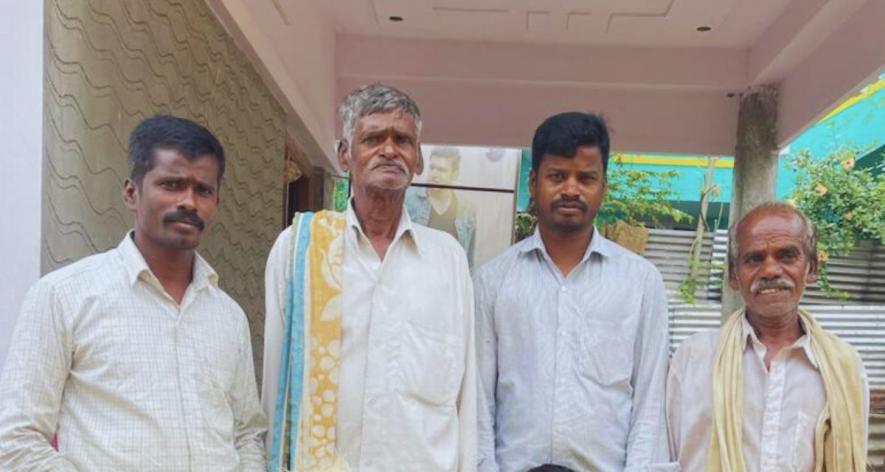
“Marketing has not been a problem for our ropes. The demand is still strong and people come in search of us. We also sell at nearby village markets,” says Venkatesh.
Entry into Design Space
Entrepreneur Raghuveer Panaghanti and architect Shruthi Ramakrishna are looking at ways to adopt natural fibres into their designs in a bid to support the fading occupation and its practitioners.
“At Indisutras, loofah [luffa cylindrica] and sisal are used as alternatives to synthetic materials. Body and utensil scrubbers, indoor slippers and decor pieces are made from loofahs. Straw cleaners, body scrubbers and soap-saver pouches are made from sisal. As loofah has no demand as a vegetable, we felt compelled to explore the material’s hidden potential. We have been working with farmers to cultivate loofah,” says Panaghanti.
“To begin with, we encouraged Akkikalu Shivanna of Mudigere in Tumakuru to grow loofahs. We also started procuring the vegetable from Mysuru-based Belavala Foundation. Likewise, we have been trying to engage farmers by offering a buy-back guarantee with advance payments,” explains Panaghanti.
Shivanna has been growing loofah in six of his total eight acres for the last eight years. “There was not much profit earlier, but it is attracting entrepreneurs now. I have eight labourers to cut, clean, thread and pack loofahs. The work happens year-round. Entrepreneurs from Kerala, Tamil Nadu and Bengaluru buy loofah from me and export it to the US, Dubai and Germany. I sell them for Rs 9 to 10 per piece. The threaded loofahs [for hanging] get me Rs 14. When the business is good, I make a profit of Rs 30,000 to 35,000,” Shivanna tells 101Reporters.
Indisutras outsources a portion of its work to self-help groups in and around Kanakapura in Karnataka. “The machines are custom-made and hence priced higher. Our focus is entirely on B2B [business-to-business], but creating a network has been a gradual process. We were funded by the Karnataka Government through their startup initiative, Elevate 2021, which turned out to be crucial in expanding our research and development efforts to create high-quality products,” says Panaghanti.
Shruthi Ramakrishna, architect, Made In Earth, has been looking for sustainable materials to promote architecture that is more mindful of people, the environment and local resources. She uses naturalistic building components and methods. “We have yet to come across any other Indian artist working with loofah, especially in architecture or product design space. Sisal, however, is used for carpet weaving,” Ramakrishna explains.
Loofahs were deseeded, peeled, unfolded and hand-sewn into a big quilt by its women loofah cultivators. At night, the stacked loofahs transform into an illuminated installation, inspiring thought on the idea of sowing as a proactive act of creating meaningful relationships with one’s land and people.
“The exhibit titled ‘The Future Will Be Sown’ will be showcased at the Dubai Design Week, from November 7 to 12. This is a call for profound shifts in our relationship with the environment, urging us to honour nature and communities while weaving together a regenerative future through renewable resources,” says Agnimitra Bachi, an architect at Made in Earth.
No doubt, there is a need for more such spaces for regenerative growth and climate action.
(Dr Lakshmi Unnithan is a Karnataka-based freelance journalist and a member of 101Reporters, a pan-India network of grassroots reporters.)
Get the latest reports & analysis with people's perspective on Protests, movements & deep analytical videos, discussions of the current affairs in your Telegram app. Subscribe to NewsClick's Telegram channel & get Real-Time updates on stories, as they get published on our website.










